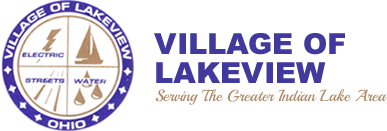Upcoming Events
Lakeview Blog
History of Lakeview

1895
The Village of Lakeview was platted in 1881 on lands owned by L. T. Dysert and his wife, Sarah. They ran a small trading post in their home. The village grew rapidly. In 1895 two hundred signatures of people who were eighteen years of age or older were needed to sign a document that would incorporate the village of Lakeview. So they signed, and Lakeview was born. The first mayor of Lakeview was Elisha Houchins. He served in 1895 and 1896 and succeeded in having an ordinance passed to build sidewalks in the village. The first ones were make of bark from the sawmill, but soon those walks on Main and Lake Streets were replaced with cement.
Also in 1895, the Toledo and Ohio Central railroad came through Lakeview. Four passenger trains a day stopped to deliver passengers and mail. Freight trains came through each day to deliver coal and other staples, and to pick up lumber, grain, fruit, vegetables, and other freight. In 1899, telephone service reached Lakeview.
The first business in Lakeview that employed more than two people, was a sawmill, built and owned by Henry Porter. The second one was a stave factory. Staves are strips of wood, slightly curved, to form the walls of a barrel.
Earl Moore built a tile mill which later operated under the name of David Bayer and Sons. A lumber yard was set up near the railroad, followed by the building of a grain elevator.
1900's
The Ohio Electric Railway (the interurban) came through in 1908, bringing passengers from near and far. Often, as many as twenty electric cars stopped here each day.
In the early 1900’s, one of the great restaurants in Lakeview offered a bowl of soup of the day, a breaded veal sandwich, and a slice of pie for five cents – each!
1910
The Van Horn Funeral Home was founded by E. L. Van Horn on May 10, 1910, and was operated by several generations of the VanHorn family. Black horses and black vehicles were used by Mr. Van Horn for funerals. In contrast, white horses and white wagons were used to carry sick or hurt people to the Electric Railroad depot where they were then transported to a hospital in Lima.
Other places of note in Lakeview were Kerr’s Drug Store, Stubb’s Landing, Marshall’s Landing, and Lyon’s Landing, the harbor at Lakeview changed several times over the years.
1912
In 1912, electricity came to Lakeview. Distribution lines were put up, made possible by a bond issue of twelve hundred dollars. Concrete streets and a water system were built in 1920. Thanks to electricity, an ice-making plant started business in the early 1930’s.
1913
A concrete retaining wall was built between Lakeview and Russell’s Point in 1913. Also in 1913, there was a real automobile service station opened.
Lakeview became an integral part of the Sandy Beach Amusement Park, and several Lakeview citizens were employed there. The village also had a small bar, a poolroom, and “Giggles” Dance Hall, where left handed Harry Taylor played the fiddle.
In Stokes Township, near Lakeview, there was a big barn owned by the Farmers’ Association, where they met and stored their engines, separators, and thrashers. When the farmers met there, their wives would bring a lot of food, such as a washtub full of mashed potatoes, another filled with fried chicken or chicken and dumplings, biscuits galore and plenty of coffee and lemonade.
1940's
And in the 1940’s, Grace Elder operated an ice cream shop. A hardware store was in business for many years and there was a car dealership that sold Kaiser-Frazers. Other businesses in the 1940’s and 1950’s were Elder’s Clothing Store, a Western Auto Store, a telephone exchange, Farmers’ Bank, a US Post Office, John Bank’s barber shop, Tommy Marshall’s IGA Store, two or three restaurants, Roger and Iona Baggs Furriers, who bought, stretched and sold furs, Steve’s cottages, and a Gulf Service Station.
1950's
In the 1950’s, Bonnie Mitchell’s Minstrel Shows were performed in Lakeview, and there was John Frazier’s book store, Ed Erschel’s shoe repair shop, “Pop” Allen’s garage, the Geiger Hotel, a meat marked on one corner and a water pump on another corner, and there was Frank Harris’ Beer. Over time there was also a battery store, a drop-off cream station, a state liquor store, another bank, a welding shop, a Ford agency, a small jail, Beck’ s IGA, a wood worker, a plumbing company, and the American Legion Post #752.

